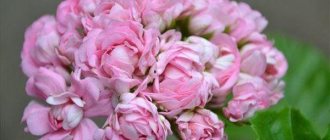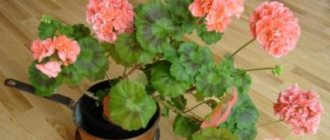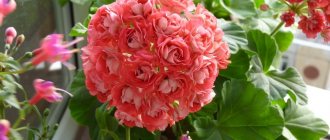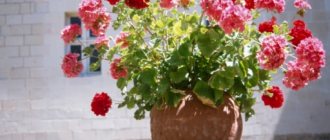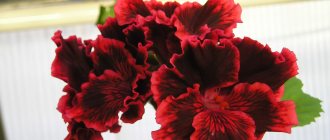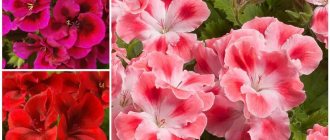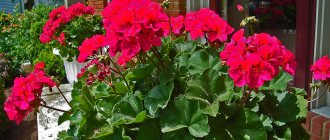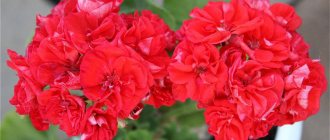Terry geranium - what kind of pelargonium is it?
Terry geranium (pelargonium) belongs to the Geraniaceae family. About 500 species of this plant are known. Today, breeders have bred geraniums in almost all colors of the rainbow and all kinds of shades.
This flower is native to South Africa. It was first bred in 1631 by an English botanist and was initially called geranium. Much later, in 1789, the current name appeared.
Terry geranium is a zonal variety of pelargonium. Large spherical inflorescences, resembling roses in appearance, are located on the upper branches of the plant. This species appeared in the middle of the 19th century.
For your information! Pelargonium terry is not related to the genus Geranium.
Features of the flower
Terry geranium with roses contains several corollas, each of which contains more than 8 petals. On a tall, thick, strong stem there are round leaves with wavy edges. In many geraniums, the edges of green leaves are framed by a thin rim of burgundy or purple. There are rare varieties with black, golden, bronze and purple leaves.
The diversity of species and varieties of Geraniaceae Pelargonium depends on changes in its genome. Sometimes this happens spontaneously. If a flower of a certain variety turns out to be different from the sample, then in such cases they say that pelargonium has acquired a sport. The shape and color of petals, leaves, stem size, density of inflorescences and much more change.
Note! Pelargonium purifies the air, drives away pests from neighboring plants, and repels mosquitoes.
The best varieties of terry pelargonium for growing at home
There are many different varieties of terry geraniums, which gardeners are happy to grow in rooms, gardens, flower beds, and summer cottages. In their descriptions, a lot of attention is paid to the color of the petals and the size of the bush.
Pelargonium Pebbles
Pelargonium Pebbles has crimson flowers with a white center. The back of the petals is white. The plant is very small, so it does not require abundant watering. It bushes actively and does not need to be shaped. The lower leaves never dry out. In bright light, a dark green spot appears in the middle of the leaf.
Pelargonium Mimi
Miniature pelargonium Mimi is distinguished by its pink-fawn petals. It actively blooms and grows; it is not necessary to form it. You can prune the branches a little to make the bush compact. Pelargonium Mimi is ideal for a greenhouse, room, flower bed.
Pelargonium Mallorca
Incredibly beautiful, bright Mallorca pelargonium is characterized by its small height. Its petals are painted in 2 colors: white and pink, sometimes red. Pelargonium Mallorca grows quickly and spreads widely, so its branches need to be periodically pruned.
Note! This variety should not be confused with the Majorca variety, which is topped with pale pink or white flowers. Mallorca is a zonal species, while Mallorca pelargonium is a cactus species.
Pelargonium Saxdalens Selma
Pink flight flowers on a small bush are a distinctive feature of Selma pelargonium. The back side of the petal is slightly lighter. The flowers form very large and dense inflorescences, so the plant looks like a rose. Selma is a zonal pelargonium. It will decorate any flower bed, garden or room. Due to its external resemblance to a rose, the flower looks luxurious.
Silk Moira
The light apricot shade of the petals is the pride of the Shelk Moira variety. A light green circle is visible in the center of each leaf. A miniature bush with a dense inflorescence looks elegant and resembles a bouquet of roses.
Brookside Fantasy
A very small bush with lilac or soft pink flowers suitable for growing in pots on a windowsill. The leaves have an unusual color: in the center and along the edges they are light green, and in the center there is a ring of a darker shade.
Bold Carmine
Bright red, crimson, burgundy flowers are a distinctive feature of the Bold Carmine variety. They bloom actively, abundantly, luxuriantly, and bush quickly. This is one of the most profusely flowering varieties.
Geranium Majesta
Majesta is a pelargonium with bright, juicy petals of a reddish-purple color. Lush, dense inflorescences decorate a low bush that branches and grows well.
Ludwigsburger Flair
The light pink and white flowers of Ludwigsburger Flair look charming. There is a green core in the center. The reverse side of the petal is white or very light. The peculiarity of this variety is that it does not tolerate dry air, low temperatures and open solar radiation. It needs a little shade.
Lara Harmony
Pink or crimson flowers make Lara Harmony look like rose bushes. The inflorescences are thick and dense, the bush is actively growing. The plant requires careful treatment and good care.
White terry geranium is a favorite of many gardeners. She looks tender, pure, defenseless. This plant blooms from March to November, actively grows and branches. You can choose the following types of white pelargonium:
- Ise Rose;
- Jacky Gauld;
- Joan of Arc;
- PAC Blanche Roche;
- PAC Viva Carolina.
Geranium Himalayan Plenum belongs to the Geranium family, but is also a double flower. Its lush purple petals form large inflorescences on a tall bush. This plant can be grown in the garden or flower bed.
For your information! The name Pelargonium means “stork” in ancient Greek. The plant was named so because the shape of the petals and seed pod resembled the beak of a stork.
How often does terry geranium bloom: periods of hibernation and activity
Terry geranium can bloom for several months: from February to September. Each part blooms for 20–30 days. During the season, all the inflorescences manage to replace each other in turn. Pelargonium blooms only with plenty of light and good care.
Himalayan geranium Plenum
An unusually beautiful pelargonium will be the ideal decoration for a room. According to legend, it brings good luck. But for this it is necessary to provide her with the necessary conditions and care.
Features of plant flowering
Caring for ampelous geranium or ivy-leaved pelargonium: diseases and pests
Without its luxurious inflorescences, geranium looks unattractive. You can achieve abundant flowering from it by providing suitable conditions.
Typically, pelargonium blooms in spring and summer. With the onset of the autumn-winter period, only those plants for which the optimal lighting regime has been created will bloom. When kept on a southern or western window, the inflorescences may not leave the bush throughout the summer. But it is worth considering that without proper rest they will gradually become smaller, less lush and bright.
In appearance, the inflorescences and the flowers of rosebud geranium themselves may differ depending on what varieties and species were used when breeding this particular plant. The buds of some hybrids are very dense and most similar to roses, like those of red rosebud pelargonium. In other varieties, the buds may be more disheveled and loose.
Terry geranium: description
Terry rose geranium is a perennial plant with large spherical inflorescences, which consist of corollas with eight or more petals. The leaves are round with wavy edges. There are rare varieties with black, golden, bronze and purple leaves.
The varieties are not distinguished by their height, most of them are specially bred hybrids
On a note! Geranium and pelargonium are different plants (pelargonium is indoor, geranium is garden). Pelargonium terry is not related to the genus Geranium. Despite this, confusion in names often occurs. Many people are more accustomed to calling a flower on a windowsill or flower bed a geranium.
How to plant a plant in the garden
It is best to plant the plant in open ground when the soil is well warmed up. At this time, the air is usually well warmed up, and the frosts have stopped.
If a pot is selected for growing a plant, then you need to know the capacity of the pot. You should not take containers with too large a volume. It should maximally exceed the volume of pelargonium roots by one and a half centimeters around the perimeter. The bottom of the pot should be lined with brick or pebble drainage.
After this, you need to prepare an earthen mixture, which consists of turf, sand, peat and humus. Half of the substrate needs to be poured into the pot, the bush should be lowered, and then the soil should be poured into the voids. The earth should not be compacted too much. After this, the bush is watered so that water does not get on its leaves. You can simply spray the soil with a spray bottle. If ivy-leaved pelargonium is planted in a garden bed, then you need to make several holes with an interval of at least 20 centimeters. The planting material goes deep into them no more than two centimeters. This way, root shoots will form faster.
Currently reading:
- Planting to decorate the site with three types of coniferous trees
- Choosing cucumbers for open ground according to your preferences
- Varieties, planting and care of perennial rudbeckia
- Exquisite juncus (rumen) spiral-shaped in the interior
Share the news on social networks
About the author: Vladimir Petrovich Efremov
Chief agronomist of the limited liability company “Association of Peasant (Farm) Farms “Kuznetsovskaya””, Ilovlinsky district of the Volgograd region.
The best indoor varieties
There are about 500 varieties of geraniums, differing in the shade of the petals and the size of the bush:
- Pelargonium pebbles. This is a compact, neat bush that does not require shaping. Compared to the small size of the plant itself, the double pink-crimson flowers look even larger.
- Pelargonium Mimi. Terry dwarf pelargonium Mimi is recognizable by the soft pink hue of its inflorescences. The bushes grow very slowly.
- Mallorca pelargonium. The unusual shape of the flowers of the Mallorca pelargonium (you can find such names as Mallorca pelargonium, Majorca, majorca) explains the classification of this variety as a cactus. The main feature of the plant is its jagged petals with red, white and greenish stripes.
- Pelargonium Saxdalens Selma. Selma is a pelargonium with strong, low shoots and soft pink inflorescences. It will decorate any flower bed or room.
- Silk Moira. This is a spectacular variety of terry pelargonium. The miniature bush is decorated with dense light apricot inflorescences.
- Brookside Fantasy. This representative of zonal pelargoniums attracts attention with bright pink flowers. Neat bushes form independently.
- Bold Carmine. Compact plant with bright foliage and crimson flowers. Bold Carmine is characterized by active, abundant flowering.
- Pelargonium Majesta. This is a geranium with bright purple flowers. The low bush readily branches and develops.
- Ludwigsburger Flair. A dwarf variety that requires the formation of a bush. The pink tint of the petals becomes brighter towards the center.
- Lara Harmony. When fully opened, the lush, bright pink flowers of this variety are incredibly rose-like. The size of the bush and the color of the leaves are standard.
The underside of the petals is almost white, so it gives the impression of two colors
Other varieties
The list can be supplemented with the following varieties:
| Name | Inflorescences |
| le Pirate | Reds |
| PAC Viva Maria | White with a crimson spot at the base of the petals |
| Lake | Pink, becoming almost white towards the edges |
| Plenum | Changes from blue to lavender |
| Elmsett | Cream with red dots |
White terry geranium (Delta Pearl, Artic Princess, Joan of Arc, PAC Blanche Roche) is especially popular among gardeners.
Diseases and pests
Pelargonium has high immunity, so pests and diseases rarely bother it. But if not properly cared for, problems can still arise.
Blooming Pelargonium Hilda
If the plant is in the wrong place or has an incorrect watering schedule, this is indicated by the following signs:
- lack of flowering;
- rusty or dried leaves;
- rotting of the root system.
It is necessary to immediately eliminate the cause of the disease and treat the plant with fungicides.
In some cases, aphids, mealybugs or whiteflies may appear on the bush. When they are detected, the flower is sprayed with insecticides.
With proper care, pelargonium will become an excellent ornamental plant with bright, unusual flowers.
Features of care
Among the decorative flowering indoor flowers, there are very few representatives as attractive and at the same time unpretentious in care as the house geranium. The flower is comfortable at room temperature. It tolerates summer heat well.
On a note! In winter, you should ensure that the leaves of the plant do not touch the cold glass.
Pelargonium is a light-loving flower; with a lack of lighting, its decorative effect is lost. In summer, it is advisable to cover its leaves from direct sunlight. The rest of the year she is only happy for the light.
Geranium does not like when air humidity is very high. The plant cannot be sprayed. The room should be ventilated more often.
In summer, pelargonium needs daily watering, but the soil should not become waterlogged and water should not get on the leaves and inflorescences. In winter, geraniums are watered less often - 2-3 times a week.
Features of caring for ivy-leaved geranium
Many novice flower growers, when buying a flower like pelargonium, think that since this plant comes from the subtropics of South Africa, it needs well-humidified air and sunlight, and also tolerates heat well. In fact, this is not the case, and below we will discuss the nuances of growing this flower at home.
Caring for ivy-leaved pelargonium: what to consider
For pelargonium to literally produce a waterfall of flowers, you need to find the right place for it. It should be open and fairly sunny, but taking into account the fact that this is a moderately light-loving plant. Geranium ivy tolerates direct sunlight well, but it likes diffused light better.
Blooming ampelous pelargonium
In addition, it needs reliable protection from wind and temperature changes. The peculiarity of this plant is that it often tolerates a slight cold snap worse than severe cold. As for high temperatures, the summer heat does not harm the above-ground part of the flower, but the roots do not like it. Some gardeners advise on such days to place pots with plants on pallets with a moistened substrate.
Important! If the owner wants to provide the plant with a good microclimate, then the optimal temperature for summer will be 20-25°C. In winter it should be in the range of 12-15°C, but a decrease to 8-10°C is acceptable.
Flowering and dormant periods
With proper care, terry geranium blooms from February to September. During this period, all the inflorescences manage to replace each other in turn.
Terry pelargonium does not have a pronounced dormant period. In winter, the plant does not shed its leaves, but rarely blooms. During this period, it is necessary to reduce watering and abandon fertilizing. It is also advisable to reduce the temperature to +20 °C. It is better to place the flower pot on the windowsill - this way the coolness from the glass will be enough for a comfortable winter life.
Geranium is not only a beautiful, but also a useful plant. It releases bactericidal substances that kill germs. Medicinal infusions and decoctions are prepared from the leaves and roots of the flower.
History and description of the species
The high decorative qualities of the flower attract the attention of designers, florists and simply lovers of home flowers. Moreover, breeding such pelargonium is not at all difficult if you study some of the features of its content. This type of pelargonium is called “zonal” due to the presence on the leaves of a semicircular strip of contrasting color, dividing the leaf plate into zones.
The stripe has a different, darker color, the intensity of which depends on sunlight. For example, with a lack of sun, as well as in autumn and winter, pelargonium leaves sometimes become monochromatic, and in the spring the stripe appears again. This pelargonium is native to South Africa. There it grows in less favorable conditions than here, and has very tall (up to 1.5 m) stems. The culture came to Europe at the beginning of the 18th century. Here they immediately appreciated the beauty of the exotic flower, but breeding work on it began only in the middle of the 19th century (presumably in 1844). That is, the varieties of zonal pelargonium that we grow on windowsills now are the result of selection.
Modern zonal pelargonium is a lush bush of medium (0.5 m) or small (there are dwarf varieties) height. The shoots are straight, slightly pubescent (sometimes smooth), densely covered with rounded leaves, the surface of which is also fleecy. The flowers are racemose umbellate inflorescences, monochromatic or two-colored, of a wide variety of shapes and sizes. All plants are durable - they live and retain their decorative properties for up to 20 years.
The best varieties
There are so many varieties and forms of zonal pelargonium that there is a separate classification for it, dividing the species into several subgroups:
- by plant size: miniature (12–15 cm), dwarf (up to 25 cm), short (up to 35 cm), medium height and tall (over 50 cm);
- by the number of petals in a flower: simple (5 petals), semi-double (6–8 petals arranged in 2 layers) and double. (more than 8 petals nested inside each other);
- by leaf color: ordinary green (with a dark zonal spot) and variegated (with heterogeneous coloring in the form of streaks, patterns, inclusions, torn edges of yellow, brown, silver);
- according to the shape of the flowers: bouquet (simple inflorescences), pink buds (flowers similar to small roses), tulip-shaped (with tulip-shaped buds), star-shaped (with pointed petals), cactus-shaped (narrow twisted petals), phlox-shaped (two-color flowers with a light spot in middle).
In each of the groups I would like to highlight the brightest and most decorative varieties:
- pelargonium Pebbles - a dwarf variety with rather large pinkish-crimson double flowers, with a light spot in the middle;
- Shelk Moira is another dwarf pelargonium with very lush double inflorescences of a delicate salmon color;
- Bold Carmine is a semi-double variety with bright emerald foliage and carmine inflorescences on long stems;
- Noel Gordon - pink-bud, low-growing pelargonium with densely double flowers of a delicate pink shade;
- PAC Viva Maria - graceful semi-double pelargonium with luxurious two-tone inflorescences of pinkish-red color;
- Mallorca is a gorgeous cactus-like pelargonium, the flowers of which have jagged, pointed petals, striped in white, pink and greenish.
Varieties of indoor plants
How to care for ampelous geraniums at home
Geranium varieties are distinguished by their lush flowering and a wide palette of colors. Not only flowers, but also leaf blades of some varieties can have a decorative appearance.
A huge number of rosebund pelargoniums have been bred
- Rose of Amsterdam
"Rose of Amsterdam" is one of the miniature, fast-growing varieties. Terry inflorescences are painted in white and pink shades. As the plant ages, the buds become more and more vibrant.
- Supreme
"Rosebud Supreme" is distinguished by rich crimson, densely double flowers with white undersides of the petals. Under proper conditions, flowering can continue year-round.
For reference! Supreme typically enters the flowering season later than similar varieties.
- Apple Blossom
"Apple Blossom Rosebud" is one of the oldest varieties of pelargonium. It has, as the name suggests, a delicate apple green coloration with a rich pink edging.
The variety is quite whimsical and requires shading, frequent fertilization and pruning.
- Vectis
“Vectis Rosebud” is a miniature zonal variety with large wine-red buds and a light underside of the petals. Lush, disheveled inflorescences last a long time. The leaves are dark green.
- Red pelargonium "Rosebud Red"
Pelargonium Rosebud Red with deep red flowers. The inflorescences are densely packed and form almost continuously throughout the year. Does not require molding.
- Beverly park
Pelargonium with double, apricot-colored buds with a lighter, almost white edging. The leaf blades are green, darkening towards the central part.
For reference! Beverly Park - suitable for those who prefer a non-standard red color scheme.
- Princess Mary
Compact early flowering variety. The leaves are uniform green. The inflorescences are dense, greenish-white. As they fade, the petals turn pink.
- Rushmoor Golden Rosebud
Rushmoor Gold features bright pink flowers that are not too densely packed. The leaf blades are light, golden-green in color.
Breeding rules
zonal pelargonium in two ways: seeds and cuttings. The tops of the shoots are used as cuttings. They are placed in water to form roots or immediately rooted in moist soil.
Cuttings are the surest way to propagate pelargonium with double flowers, since the trait of double flowers is not transmitted through the seeds.
Flower propagation methods
Rosebud geranium reproduces just like any other variety. Most often, two methods are used: cuttings and sowing seeds.
Cuttings can be immediately planted in the ground
Reproduction by cuttings
This method can be used at any time of the year. For germination, lateral shoots with 2-3 leaves are cut from the bush.
A cut of the cutting is dipped in crushed activated carbon and placed in a shaded place for several hours. After this procedure, the cuttings can be placed in water to germinate roots.
Propagation by seeds
Propagation of geraniums by sowing seed material is a rather labor-intensive process. But in this case you can get many young viable plants.
The seeds are planted at a distance of 5 cm from each other, kept in a growth stimulator. A greenhouse is built over the crops, placed on a lighted windowsill, after which it is regularly ventilated and watered by spraying.
Additional Information! To speed up the appearance of sprouts, the seeds can be rubbed on sandpaper.
Description and characteristics of cultivation
Interestingly, among all the variety of varieties, it is dwarf geranium that is becoming increasingly popular. It has many advantages. For example, such a plant will take its rightful place on the windowsill and fit perfectly into any of your flower collections.
It is grown in a compact pot, since the flower is very miniature. Nevertheless, its small dimensions do not prevent it from blooming magnificently. Another important advantage of this group of geraniums is that formative pruning of such a flower specimen is not necessary at all.
Caring for dwarf pelargonium varieties at home is not too labor-intensive; even a beginner can handle it. However, take some recommendations into account so as not to harm your indoor flowers. For example, like most geraniums, dwarf pelargonium does not like waterlogged soil - it will cause the rhizome to rot before you even blink an eye. That's why remember two things:
- The plant substrate should be moistened in moderation;
- The soil must contain sand or vermiculite. Such components are useful because they absorb excess moisture, and you do not have to correct the consequences of waterlogging the soil.
You will certainly be able to care for low-growing varieties of pelargonium. Over time, many gardeners begin to expand their collection of dwarf geraniums. This can be done easily and at home, no extra costs will be required.
How are these flowers propagated? It is best to start this procedure at the end of February or early March. It is during this period that the plant gradually comes to its senses after wintering, and its vital processes are activated. First of all, cut the cutting with two internodes, and then dry it thoroughly.
The next stage is planting in nutrient soil. It is not recommended to cover the top of the cutting with glass or film - this will only create an excessively humid environment for the geranium, which can have a detrimental effect on it. Miniature cuttings of pelargonium will very quickly take root in a new place. The main thing is to place the pot with the shoots in a well-lit place. Under favorable conditions, within a month you will receive a fully rooted plant.
Of course, you can’t do without transplanting homemade miniature geraniums. This procedure is not performed very often. If you notice that the flower has grown sufficiently, and, most likely, there is no longer enough space for the rhizome in the mini-pot, you can place it in a slightly larger pot. But don’t overdo it: if you plant a plant in a flowerpot that is too large, it may simply die, because the root system will not fill the bottom of the container, and without this the flower will not begin to develop.
In order for pelargonium varieties Dovepoint or pelargonium Barnstondale to delight you with its lush and long-lasting flowering, you need to take care of this yourself. You can't do without feeding. Nutrient mixtures can be added to the substrate a month after planting the plant in its permanent place.
Purchase either universal nutritional formulations or special fertilizers for homemade geraniums. You should not neglect feeding the flowers, since if there is a deficiency of organic and mineral substances in the soil, the plant may suffer from chlorosis or blackleg (fungal disease).
Caring for rosebud pelargonium at home
Varieties of geraniums - what lemon and field geraniums look like
Rose geranium requires special treatment; it should be cared for by following certain rules. By adhering to them, you can achieve long-lasting lush flowering.
Watering should be regular and moderate
Illumination and temperature conditions
Pelargonium rosebud tolerates bright sunlight and partial shade. On a personal plot, it can be planted on an alpine hill, placed in a hanging flowerpot, or placed in a flowerpot in the shade of trees.
Note! When there is a lack of lighting, geranium foliage becomes lighter and may fall off, the stems become elongated, and flowering is delayed or does not occur at all.
The flower does not tolerate heat very well. Maximum permissible temperature 28 °C. Otherwise, the plant will become lethargic, and the flowers will fall off earlier than expected.
Watering rules and humidity
Pelargonium bushes should be watered sparingly. The flower tolerates drought much easier than excessive moisture and stagnation of water.
The plant almost does not react to a decrease in the level of air humidity in the room. In rare cases, the edges of the leaves may dry out.
It is not advisable to spray pelargonium. The accumulation of moisture on fuzzy leaves can cause them to rot. You can humidify the air using a tray with pebbles and water.
Fertilizing and soil quality
Soil for rosebud geranium when caring at home can be purchased in specialized stores or mixed with your own hands. Taking a universal soil mixture, you can add perlite and sand to it to achieve better air permeability.
Self-preparation of soil involves the following proportions of components:
- peat - 2 parts;
- turf soil - 4 parts;
- river sand and perlite - 1 part each;
- humus - 2 parts.
It is recommended to feed the flower from the end of February. The application of nitrogen-containing fertilizers will allow the bush to gain green mass. Closer to the onset of the flowering period, they begin to add potassium and phosphorus to the fertilizing.
Rosebud pelargonium requires feeding
Flower container size
Flowerpots for rose-shaped geraniums are selected to be small, made of unglazed ceramics. The soil in such a container will dry out better and the roots will receive enough air.
Pruning and replanting
Rosebud pelargonium is pruned twice a year. In autumn, old shoots that have shed their leaves are cut off, and elongated stems are shortened by at least a third. In spring, only gentle pinching is done, otherwise the plant may not bloom on time.
Replanting is carried out as the bush grows, but at least once every 2 years. You can tell that the pots need to be replaced by the roots coming out through the drainage holes.
Transplantation can also be carried out for the purpose of propagation by separating independent young bushes. It is recommended to carry out the procedure in the spring.
The best varieties
There are more and more new varieties of pelargonium. That is why it is worth considering the most remarkable specimens. Only this way can you make an informed choice and purchase plants that will certainly decorate your home. Among the popular dwarf species of pelargonium, the following varieties are distinguished:
- Madame Maleron. If all previous varieties of pelargonium were distinguished by the presence of bright inflorescences, then this variety does not bloom at all. Its main advantage is its beautiful dark green leaves with a light border;
- Pac Harmony. The flowers of this plant are quite large, semi-double, and have a rich pink color;
- Only Joss. The key advantage of this specimen is the presence of bright, berry-red flowers. There is a slight light inclusion in the center of the bud;
